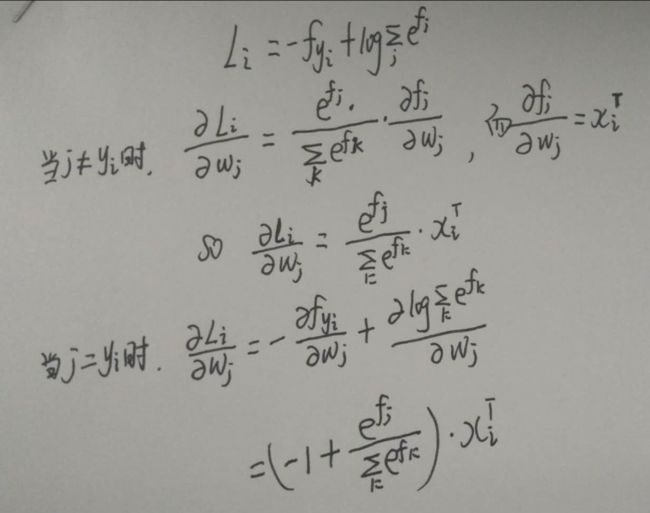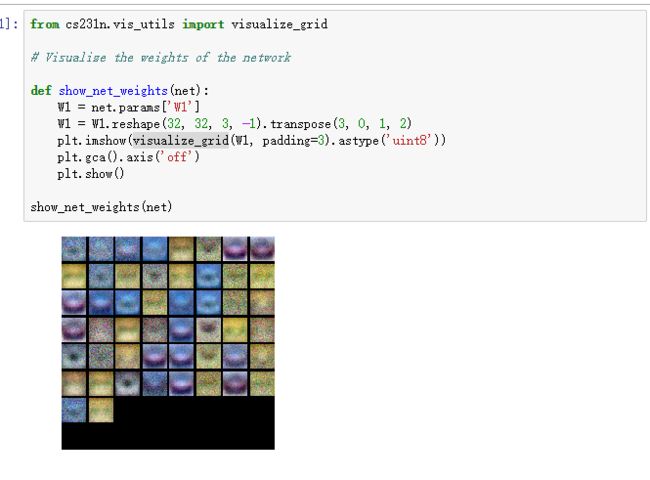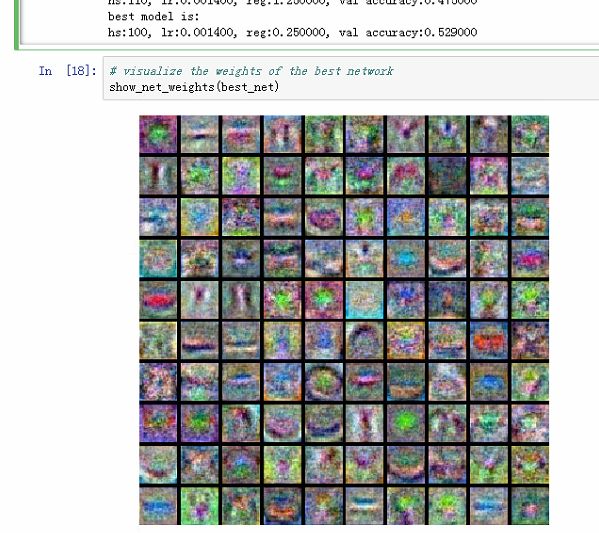cs231n-assignment1的笔记
在看完cs231n前面几章的内容后,准备做一下assignment1,然后怕之后忘记,所以写博文记录一下......
由于我是个low逼程序员,平时能用Windows就绝不用linux,所以在这次作业时使用虚拟机完成了作业,装好ubuntu16.04之后,配好环境,使用jupyter notebook查看相应的要求
Q1: k-Nearest Neighbor classifier
由于我对matplotlib并不是特别的熟悉,这里面学到的第一个点就是画图像的预览图,plt.imshow(a)中a的格式要求是width*height*depth,数据类型是无符号整型(uint8),代码如下:
classes = ['plane', 'car', 'bird', 'cat', 'deer', 'dog', 'frog', 'horse', 'ship', 'truck']
num_classes = len(classes)
samples_per_class = 7 # 每种类型采7个样
for y, cls in enumerate(classes): #enumerate(list)会返回index以及value
idxs = np.flatnonzero(y_train == y) # 取出与y标签相同的数据的索引,numpy中的flatnonzero就是取出非零的索引
idxs = np.random.choice(idxs, samples_per_class, replace=False) # 从中取样(7个)
for i, idx in enumerate(idxs):
plt_idx = i * num_classes + y + 1
plt.subplot(samples_per_class, num_classes, plt_idx) # 参数1代表行数、参数2代表列数、参数3代表第几个图,之所以每次都需要输入第1、2个参数,这两个参数是可变的
plt.imshow(X_train[idx].astype('uint8')) # 在上一条指令指定好绘制区域后,进行特定图像显示
plt.axis('off')
if i == 0:
plt.title(cls) # 仅在第一个图上面显示title
plt.show()
然后就开始实现cs231n/classifiers/k_nearest_neighbor.py中的compute_distances_two_loops函数,其实也就是一行代码dists[i, j] = np.sqrt(np.sum((X[i]-self.X_train[j])**2))
这里的知识点是计算两个vector的L2距离,所以可以简单粗暴的直接求解。
然后画出dist的分布图之后有一个问题,问白横线和白竖线分别是怎么造成的,白横线代表某一个测试样本与训练样本的距离都比较大,白竖线表示某个训练样本与测试样本的距离较大
然后要实现predict_labels
首先利用距离矩阵dists找出k个与测试样本i最近的训练样本的label,利用np.argsort可以找出dists中最小的k个值的index,然后利用index取出对应的label即可得到closest_y
closest_y = self.y_train[np.argsort(dists[i])[0:k]]
在得到closest_y之后,找到k近邻中label出现次数最多的label返回,利用np.bincount(y)可以统计y中元素出现的次数,并且返回出现次数,bincount的返回值a的每一项对应一个值出现次数,例如a[0]代表的是y中0出现次数,a[1]代表y中1出现次数......然后利用argmax求出出现次数最多的元素,返回即可:
y_pred[i] = np.argmax(np.bincount(closest_y))
之后是实现一层循环求解以及不用循环求解,这里其实也就是矩阵的操作一层循环中循环次数为测试样例的个数,所以在循环体中要实现vector和matrix的距离求解,与上面的方法是相似的
不用循环的方法则有一点trick,首先将L2距离公式展开,然后分别求平方项以及叉积。
dists[i, :] = np.sqrt(np.sum(((self.X_train - X[i])**2), axis = 1))dists += np.sum(self.X_train**2, axis=1).reshape(1, num_train) # 这里其实利用了broadcast
dists += np.sum(X**2, axis=1).reshape(num_test, 1)
dists -= 2 * np.dot(X, self.X_train.T) # np.dot(a,b)可以对两个矩阵求乘积,要求a的第二维与b的第一维长度一致
dists = np.sqrt(dists)后面是交叉验证部分,也就是抽出一部分数据作为测试集,一部分为验证集,其余为训练集,采用的是5折交叉验证法,首先将训练数据进行划分,按照作业提示,使用np.array_split将数据划分为5块,如下:
y_train_ = y_train.reshape(-1, 1)
X_train_folds = np.array_split(X_train, num_folds)
y_train_folds = np.array_split(y_train, num_folds)然后先对k_to_accuracies赋初始值[],利用两层循环进行交叉验证,外层循环为folds数,内层循环为不同的k值,这里比较简单,仅写出解决的代码
for k_ in k_choices:
k_to_accuracies.setdefault(k_, [])
for i in range(num_folds):
classifier = KNearestNeighbor()
X_val_train = np.vstack(X_train_folds[0:i] + X_train_folds[i+1:])
y_val_train = np.vstack(y_train_folds[0:i] + y_train_folds[i+1:])
y_val_train = y_val_train[:,0]
classifier.train(X_val_train, y_val_train)
for k_ in k_choices:
y_val_pred = classifier.predict(X_train_folds[i], k=k_)
num_correct = np.sum(y_val_pred == y_train_folds[i][:,0])
accuracy = float(num_correct) / len(y_val_pred)
k_to_accuracies[k_] = k_to_accuracies[k_] + [accuracy]Q2: Training a Support Vector Machine
前3步与前面knn的步骤差不多,然后第四步开始将数据分为训练集、验证集和测试集,50000个训练集中49000作为训练集,1000作为验证集。测试集只选取10000个测试样本中的前1000个。
然后从这49000个训练集中选取出500个开发集,用于调参,使用的函数为:np.random.choice(num_training, num_dev, replace=False)
第六步中求了这49000个训练集的均值并且显示,然后第七步中对所有数据进行了中心化(中心化是减去均值,标准化是减去均值后除以标准差,这个与统计学概念类似),对训练集、验证集、开发集以及测试集均减去前述49000个训练集的均值。
然后在每一条数据记录后面加上1,以便于只关注W,而不用关注b(也即是f(x, W) = Wx + b,x=(x1, x2, x3...xn)将x增加1,即x=(x1, x2, x3...xn, 1),然后f(x, W) = Wx, 其中W的最后一项即原式中的b,这个在cs229中有讲过)
后面正式开始svm分类器
svm_loss_naive
在linear_svm.py中第一种实现方式是比较naive的方式,计算loss时利用两层循环进行,对于每一个训练集,利用其乘以W之后,得到其对每个类的得分score以及正确标签的得分correct_class_score, 然后内层循环对每个类,分别计算max(0, score-correct_class_score+1), loss值为输入的所有X的loss之和的均值,然后加上一个L2正则项以防止W过于复杂,即total_loss = avg_loss + lambda * sum(W*W), 后面是我们要实现求dW, 也即求梯度,后面的代码会进行检查,比较numerical和analytic两种方式的差别,而我们要实现的就是analytical方式
根据cs231n的notes点击打开链接, Loss function对w的偏导,公式如下所示:
由于wyi在每一个max(0, wj * xi - wyi * xi + delta)中都出现了,所以求dW时每次都要加上对wyi的偏导,即在原代码中内层循环加上:
dW[:, j] += X[i].T dW[:, y[i]] -= X[i].T
后面的偏导就看loss的变化,所以svm_loss_naive函数最后实现如下所示:
def svm_loss_naive(W, X, y, reg): """ Structured SVM loss function, naive implementation (with loops). Inputs have dimension D, there are C classes, and we operate on minibatches of N examples. Inputs: - W: A numpy array of shape (D, C) containing weights. - X: A numpy array of shape (N, D) containing a minibatch of data. - y: A numpy array of shape (N,) containing training labels; y[i] = c means that X[i] has label c, where 0 <= c < C. - reg: (float) regularization strength Returns a tuple of: - loss as single float - gradient with respect to weights W; an array of same shape as W """ dW = np.zeros(W.shape) # initialize the gradient as zero # compute the loss and the gradient num_classes = W.shape[1] num_train = X.shape[0] loss = 0.0 for i in xrange(num_train): scores = X[i].dot(W) correct_class_score = scores[y[i]] for j in xrange(num_classes): if j == y[i]: continue margin = scores[j] - correct_class_score + 1 # note delta = 1 if margin > 0: loss += margin dW[:, j] += X[i].T dW[:, y[i]] -= X[i].T # 在loss公式的每一项中均出现,所以每次都要加上这一项 # Right now the loss is a sum over all training examples, but we want it # to be an average instead so we divide by num_train. loss /= num_train dW /= num_train # Add regularization to the loss. loss += reg * np.sum(W * W) dW += 2 * reg * W ############################################################################# # TODO: # # Compute the gradient of the loss function and store it dW. # # Rather that first computing the loss and then computing the derivative, # # it may be simpler to compute the derivative at the same time that the # # loss is being computed. As a result you may need to modify some of the # # code above to compute the gradient. # ############################################################################# return loss, dW
Inline Question1问的是什么时候两种梯度计算方式结果不同,很简单,对于分段函数,一般边界点的导数是不同的
接下来是使用vector操作实现loss和dW的计算,首先是loss,这个比较简单,利用矩阵的基础知识就可以写出相应代码:
num_train = X.shape[0] y_f = np.dot(X, W) y_c = y_f[range(num_train), list(y)].reshape(-1, 1) margins = np.maximum(y_f - y_c + 1, 0)# shape [N, C] margins[range(num_train), list(y)] = 0 loss = np.sum(margins) / num_train + reg * np.sum(W * W)
其实也就是循环实现方式的向量化
然后是实现dW的计算,根据上面循环方式的实现可知,对于一个sample而言,在margin[i]大于0时 (0
mask = margins mask[margins > 0] = 1 mask[range(num_train), list(y)] = -np.sum(mask, axis=1) dW = (X.T).dot(mask) dW = dW/num_train + 2 * reg * W
后面是SGD,首先实现train函数,sample的方式也就是一般机器学习里的技巧,利用np.random.choice()生成index,然后取X,y中的对应项,而更新W的方式更加简单,梯度下降,W = W - lr * dW, 代码如下:
index = np.random.choice(range(X.shape[0]), batch_size, replace=True) X_batch = X[index] y_batch = y[index]
self.W -= learning_rate * grad
接下来是实现预测函数predict,这个较简单,一行代码搞定:
y_pred = np.argmax(X.dot(self.W), axis=1)
接下来是实现寻找最优超参的过程:
for reg in regularization_strengths: for lr in learning_rates: svm = LinearSVM() loss_hist = svm.train(X_train, y_train, lr, reg, num_iters=1500) y_train_pred = svm.predict(X_train) train_accuracy = np.mean(y_train == y_train_pred) y_val_pred = svm.predict(X_val) val_accuracy = np.mean(y_val == y_val_pred) if val_accuracy > best_val: best_val = val_accuracy best_svm = svm results[(lr, reg)] = train_accuracy, val_accuracy
Q3: Implement a Softmax classifier
实现softmax, 首先是naive方式,即for循环实现,根据notes点击打开链接中的提示,计算exp的值有时候会变得十分之大。例如exp(500)之类的值,所以一般利用减去最大值使得其余的值均小于0,此时exp(x)的值仅在(0, 1]之间,证明公式如下所示:
而求dW则就是简单的求导法则了,自己用笔推算了一下,如下:
再与之前一样,加上正则项,完成,所以softmax_loss_naive函数的具体实现如下:
num_train = X.shape[0] num_classes = W.shape[1] for i in range(num_train): scores = X[i].dot(W) adjust_scores = scores - np.max(scores) loss_t = -np.log(np.exp(adjust_scores[y[i]]) / np.sum(np.exp(adjust_scores))) loss += loss_t for j in range(num_classes): prob = np.exp(adjust_scores[j]) / np.sum(np.exp(adjust_scores)) if j == y[i]: dW[:, j] += (-1 + prob) * X[i] else: dW[:, j] += prob * X[i] loss = loss / num_train dW = dW / num_train loss += reg * np.sum(W * W) dW += 2 * reg * W
然后测试中为何要使loss接近-log(0.1),这是因为我们的W是随机生成的,所以其对于每个class得到的结果在概率上应该差距不大,总class为10,则其正确的概率就是0.1
接下来是实现向量化的softmax,对于loss的求解较简单不再赘述,dW的求解与前述的求导是一致的,与Q2中的mask类似,根据前面naive的实现方式可知,在j==y[i]时需要-1,so 代码如下:
num_train = X.shape[0] scores = X.dot(W) adjust_scores = np.exp(scores - np.max(scores, axis=1).reshape(-1, 1)) sum_scores = np.sum(adjust_scores, axis=1).reshape(-1, 1) class_prob = adjust_scores / sum_scores # shape [N, C] prob = class_prob[range(num_train), list(y)] total_loss = -np.log(prob) loss = np.sum(total_loss) / num_train + reg * np.sum(W * W) class_prob[range(num_train), list(y)] -= 1 dW = (X.T).dot(class_prob) dW = dW / num_train + 2 * reg * W
其中class_prob计算了所有的exp(fj)/sum(exp(f))......
接下来又是寻找最优超参的过程,与Q2的类似,不再说明。。。
for lr in learning_rates: for reg in regularization_strengths: softmax = Softmax() softmax.train(X_train, y_train, lr, reg, num_iters=3000) y_train_pred = softmax.predict(X_train) train_accuracy = np.mean(y_train == y_train_pred) y_val_pred = softmax.predict(X_val) val_accuracy = np.mean(y_val == y_val_pred) if val_accuracy > best_val: best_val = val_accuracy best_softmax = softmax results[(lr, reg)] = train_accuracy, val_accuracy
后面有一个可视化W的方法,虽然不是作业,但比较有意思,对于W,其shape是D * C,其中D是与输入X(图片)有关,C是类别数,然后对于W中的元素,归一化之后乘以255,得到相应的像素值,代码如下(来自cs231n-assignment1-softmax.ipynb):
# Visualize the learned weights for each class w = best_softmax.W[:-1, :] # strip out the bias print(w.shape) w = w.reshape(32, 32, 3, 10) w_min, w_max = np.min(w), np.max(w) classes = ['plane', 'car', 'bird', 'cat', 'deer', 'dog', 'frog', 'horse', 'ship', 'truck'] for i in range(10): plt.subplot(2, 5, i + 1) # Rescale the weights to be between 0 and 255 wimg = 255.0 * (w[:, :, :, i].squeeze() - w_min) / (w_max - w_min) plt.imshow(wimg.astype('uint8')) plt.axis('off') plt.title(classes[i])
Q4: Two-Layer Neural Network
这里要实现两层神经网络,首先是loss函数中的scores的计算,根据lecture4的slides可以得知,多层神经网络的score函数如下所示:
h1 = np.maximum(0, (X.dot(W1) + b1)) scores = h1.dot(W2) + b2
然后实现loss, 前向传播过程,同时也需要加入正则项(题中使用L2正则项),loss函数为Softmax classifier loss
adjust_scores = np.exp(scores - np.max(scores, axis=1).reshape(-1, 1)) # [N, C] sum_scores = np.sum(adjust_scores, axis=1).reshape(-1, 1) # [N, 1] class_prob = adjust_scores / sum_scores # [N, C] prob = class_prob[range(N), list(y)] # [N, 1] total_loss = -np.log(prob) # [N, 1] loss = np.sum(total_loss) / N + reg * (np.sum(W1 * W1) + np.sum(W2 * W2))
接下来是求gradients, 这个看起来无从下手,其实与之前Q3 的softmax是类似的,但我做Q3时还没看过Lecture4和5,所以直接推导公式,感觉很抽象不容易理解,看了lecture4点击打开链接的后向传播求梯度后就简单很多了。
求dW2和db2较简单,与之前softmax一致:
dscores = class_prob dscores[range(N), list(y)] -= 1 dscores /= N grads['W2'] = (h1.T).dot(dscores) grads['b2'] = np.sum(dscores, axis=0)
根据scores = h1.dot(W2) + b2可知,dh1 = dscores.dot(W2.T),由此可知:
dh1 = dscores.dot(W2.T) dh1_raw = dh1 * (h1>0) grads['W1'] = X.T.dot(dh1_raw) + 2 * reg * W1 grads['b1'] = np.sum(dh1_raw, axis=0)
接下来写train函数,第一部分与之前的一致,也就是随机采样:
index = np.random.choice(num_train, batch_size, replace=True) X_batch = X[index] y_batch = y[index]
更新参数:
self.params['W2'] -= learning_rate * grads['W2'] self.params['b2'] -= learning_rate * grads['b2'] self.params['W1'] -= learning_rate * grads['W1'] self.params['b1'] -= learning_rate * grads['b1']
最后是predict函数:
W1, b1 = self.params['W1'], self.params['b1'] W2, b2 = self.params['W2'], self.params['b2'] h1 = np.maximum(0, (X.dot(W1) + b1)) scores = h1.dot(W2) + b2 y_pred = np.argmax(scores, axis=1)
在debug the training中演示了如何debug,主要通过做出loss的图以及分类准确率,比较有意思的是将W1的图做出来了,可以发现W1中模糊可见一些汽车的影子,说明分类效果并不好:
接下来是寻找最优参数的过程:
best_val_acc = 0 best_lr = 0 best_hs = 0 best_reg = 0 learning_rates_base = 0.001 learning_rates_step = 0.0001 hidden_size_base = 60 hidden_size_step = 10 reg_base = 0.25 reg_step = 0.25 for hs_count in range(5): for lr_count in range(5): for reg_count in range(5): hs = hidden_size_base + hs_count * hidden_size_step lr = learning_rates_base + lr_count * learning_rates_step reg = reg_base + reg_count * reg_step net = TwoLayerNet(input_size, hs, num_classes) results = net.train(X_train, y_train, X_val, y_val, num_iters=2000, batch_size=200, learning_rate=lr, learning_rate_decay=0.95, reg=reg, verbose=False) val_acc = np.mean(net.predict(X_val) == y_val) print("hs:%d, lr:%f, reg:%f, val accuracy:%f"%(hs, lr, reg, val_acc)) if val_acc > best_val_acc: best_val_acc = val_acc best_net = net best_hs = hs best_lr = lr best_reg = reg print("best model is:") print("hs:%d, lr:%f, reg:%f, val accuracy:%f"%(best_hs, best_lr, best_reg, best_val_acc))
这个区间可以自己设置,我在hs = 100, lr = 0.0014, reg = 0.25时取到最优结果,验证集准确率为52.9%。w1的图如下所示:
Q5: Higher Level Representations: Image Features
前面的作业是让神经网络训练寻找特征,但是通过对前面W1进行查看,发现其寻找到的特征并不是很理想,而这个作业则是通过改进特征提取过程来改进效果。
首先来看看features.py中的各个函数
extract_features函数就是应用各个feature functions, 然后组合而成新的特征向量,其中每个feature function应该返回一个一维向量,然后多个feature functions返回值组合形成新的特征向量。
rgb2gray就是将rgb图值转换为灰度图,这里直接使用公式:Gray = R*0.299 + G*0.587 + B*0.114
hog_feature则是提取方向梯度直方图
color_histogram_hsv利用hsv颜色模式计算颜色直方图
然后运行Extract Features中的代码时发现会提示错误:
slice indices must be integers or None or have an __index__ method
问题定位在features.py的121行,发现应该是python2和python3对除法的操作不一致所致,而slice操作需要的是一个整数,由于作业使用的环境应该是python2,而我使用的是python3,所以将该行代码改为整除的形式:
orientation_histogram[:,:,i] = uniform_filter(temp_mag, size=(cx, cy))[cx//2::cx, cy//2::cy].T
然后就正常了,接下来利用抽取的feature训练SVM分类,这个过程与之前的寻找最优参数的过程类似
for rs in regularization_strengths: for lr in learning_rates: svm = LinearSVM() svm.train(X_train_feats, y_train, lr, rs, num_iters=3000) y_train_pred = svm.predict(X_train_feats) train_accuracy = np.mean(y_train == y_train_pred) y_val_pred = svm.predict(X_val_feats) val_accuracy = np.mean(y_val == y_val_pred) if val_accuracy > best_val: best_val = val_accuracy best_svm = svm results[(lr,rs)] = train_accuracy, val_accuracy
神经网络的与上类似,主要是调参过程,然而并没有找到合适的参数。。。
best_val_acc = 0 best_lr = 0 best_hs = 0 best_reg = 0 learning_rates_base = 0.01 learning_rates_step = 0.01 reg_base = 0.25 reg_step = 0.25 for lr_count in range(5): for reg_count in range(5): lr = learning_rates_base + lr_count * learning_rates_step reg = reg_base + reg_count * reg_step net = TwoLayerNet(input_dim, hidden_dim, num_classes) result = net.train(X_train_feats, y_train, X_val_feats, y_val, num_iters=2000, batch_size=200, learning_rate=lr, learning_rate_decay=0.95, reg=reg, verbose=False) val_acc = np.mean(net.predict(X_val_feats) == y_val) print("hs:%d, lr:%f, reg:%f, val accuracy:%f"%(hs, lr, reg, val_acc)) if val_acc > best_val_acc: best_val_acc = val_acc best_net = net best_lr = lr best_reg = reg print("best model is:") print("hs:%d, lr:%f, reg:%f, val accuracy:%f"%(best_hs, best_lr, best_reg, best_val_acc))
Q6: Cool Bonus: Do something extra!
待填坑......







